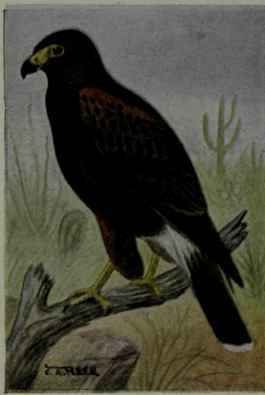Harris Hawk
Description
This section is from the book "Bird Guide: Water Birds, Game Birds And Birds Of Prey East Of The Rockies", by Chester A. Reed. Also available from Amazon: The Bird Book.
Harris Hawk
335. Parabuteo unicinctus Jiarrisi. 20 in.
Tail coverts, base and tip of tail, white. Adults with the shoulders, thighs and under wing-coverts, reddish-brown. Young with rusty edgings to feathers on the back; below, rusty buff with blackish spots or streaks; thighs barred with blackish. Space in front of eye, bare except for stiff hair-like bristles, yellowish like the cere. This species is the connecting link between the vultures and hawks of the genus buteo. Its feedings habits are similar to those of the vultures, with which it often associates when feeding upon carrion. They are very sluggish birds and their flight is slow and heavy: when not feeding they are usually perched on one foot on some dead limb, dozing.
Nest. - Made of sticks, twigs and weeds, placed in bushes or low trees. Their three or four eggs are dull white, unmarked (2.10 x1.65).
Range. - Mexico, north to southern United States chiefly in Texas, but also found in New Mexico and casually east to Louisiana.

Continue to:


